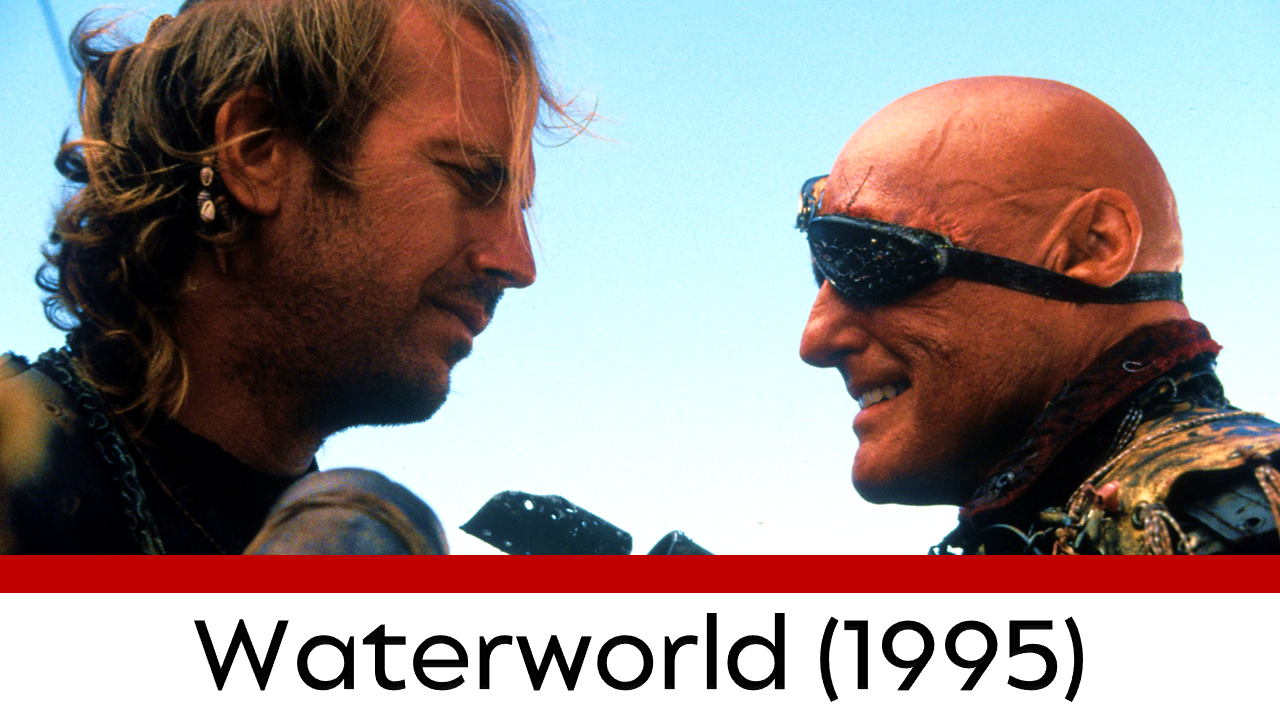Given the cavalcade of box-office flops we’ve had over the last few years, I was scrolling through the list of movie disasters and came across a film that’s still notorious after almost 30 years. Waterworld was launched in ’95 to massive expectations, only to sink faster than the cities of the film’s setting.
The story follows “The Mariner,” a lone sailor in a world where melting ice caps have submerged human civilisation, our nameless, heartless hero drifting between the floating outposts of humanity. This all changes when he takes on board Helen and her adopted daughter Enola, the latter of which has a strange tattoo on her back that shows the way to the mythical “Dryland.” Out to take the child for themselves are the Smokers, techno barbarians who’ve wandered out of a mad Max film and found some jetskis, led by the ruthless and charismatic Deacon.
One of the largest reasons for the film’s legendary budget blowout was the use of physical sets, director Kevin Reynolds insisting on building and filming his watery epic with as little CGI as possible. This was dismissed as lavish spectacle at the time, but from the perspective of 2024, I loved it. The Mariner’s strange outrigger, the floating fortress of the Atoll, Deacon’s own ship being revealed as a refloated Exxon Valdez – every scene is full of rust, grime and make-do repairs that gives it real character. I was also surprised at how many different types of shots Reynolds was able to use, rather than the usual “actors centred on the green screen” composition we’ve had to live with. Everything in this film looks wonderfully dilapidated and decayed, from the weapons to the costumes to Kevin Costner’s receding hairline.
The Mariner gets a 1950’s cowboy-style character arc, the hard-hearted loner slowly coming to care for, then actively protect Helen and Enola. While his connection to Enola is very sweet, the early scenes of his rough handling of female characters is a little uncomfortable when seen from 2024.
Another surprise was how little dialogue there is in this film, which demonstrates rather than describes the setting and context. This wasn’t a film for witty banter, Kostner’s performance as the taciturn, violent Mariner given largely through action and body language. The exception is Dennis Hopper as Deacon, with Hopper enjoying himself as the bombastic, cigarette-smoking, cult-leading villain. Hopper sometimes goes a little overboard (pun intended), almost becoming a pantomime villain by the end of the flick.
The story structure is well-paced, the first act developing the setting and characters, the second act focusing on the growing relationship between Helena, Enola and the Mariner. The third act however is overwrought, going hard into explosions, heroic last stands, and a seemingly killing off the villain two or three times before he’s finally defeated. There were also a few eye-rolling “get out of jail free” cards, such as the eccentric grandfather with a balloon, who seems to know exactly when and where to show up to save everyone.
Overall, Waterworld was a weird mash of genres, part 1950s cowboy film, part 1980s action flick, part 1990s dystopian sci-fi. I wouldn’t say this one is an overlooked gem, but it’s worth a watch to see how much films have changed. Failing that, they still run the Waterworld stage show at Universal Studios, which breezily ignores the film’s theatrical flop and just has fun with the setting.
Agree? Disagree? Please leave a comment below!

Leave a Reply